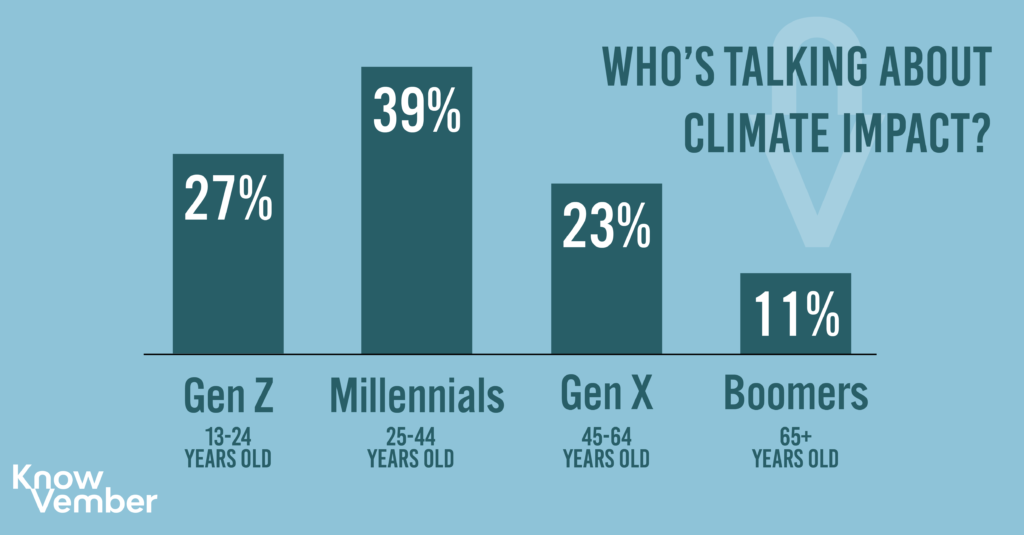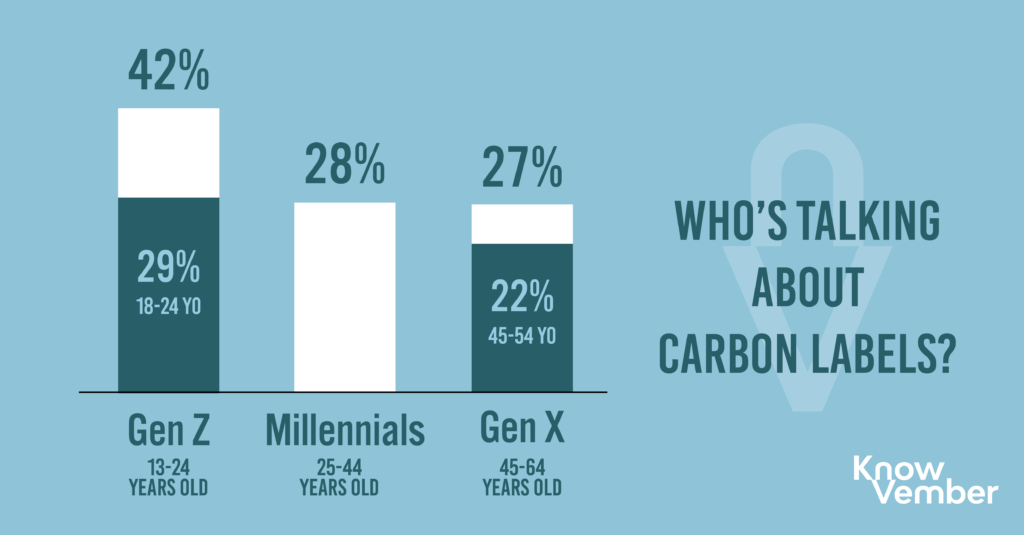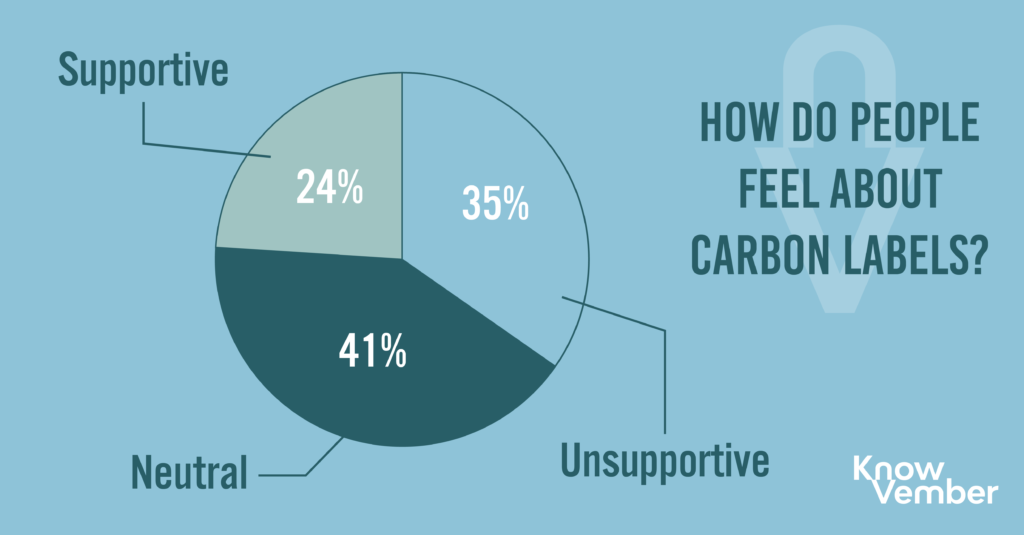EBOOK
Meet the climate transparency audience
The Brits talking about the climate impact of food
If you do a quick sweep of climate communication from food brands, you’ll see that, too often, it is narrative-driven. But, what would climate-transparent communication look like if it was data-driven? We tuned in to the digital discussions on climate transparency and mapped out the climate-conscious audience.
Who are the climate-conscious consumers? What do they expect to hear from brands? What are their sentiments and what are they most likely to respond to? Overall, who will vote for climate transparency with their wallet and why?
Knowing the climate footprint of a food product is a few calculations (or clicks!) away but finding out what the general audience thinks about it is not as easily calculable. To bridge this knowledge gap, the Knowvember movement issued a social listening report on the UK’s consumer awareness and understanding of the climate impact of food.
Knowvember is firm on food brands knowing and showing their climate footprints and with this report, it aims to bring insights into how to make the “showing” part as effective as possible. We tuned in to the digital discussions on climate transparency and here’s the map of the climate-conscious audience.
An overview
Who is talking about climate footprint labels?
The majority of online discussions on the climate impact of food comes from individuals, at 55%. The remaining 45% of the discussion comes from organizations, including media outlets.
Download the ebook & listen in on consumer discussions
Regarding the demographics of people discussing the climate impact of food, some of the results may confirm your assumptions and some may surprise you.
- 27% of the discussion comes from Gen Z (13-24).
- 39% of the discussion comes from Millennials (25-44).

The most active age group here is the 25-34 range, holding 28% of the overall discussions on the climate impact of food.
- 23% of the discussion comes from Gen X (45-64)
- 11% of the discussion comes from Baby Boomers (65+)
The majority are Londoners (38%), followed by Edinburgh, Manchester, Glasgow, Cambridge, and Oxford
📍 Now put a pin on those, because this data will reveal the story as our focus sharpens.
Who is talking about the climate impact of food?
Only 4% of the discussion on the climate impact of food and drinks referred to climate footprint labels.
- The dominant group (47%) discussing climate footprint labels is private individuals.
- 35% of the label discussions originates from organizations.
The food and drink industry dominates this space with 36%, with media following at 24% and sustainability at 16%.
- 18% of the discussions are from individuals in their professional capacity.
The most prominent professional domains in this part of the pie are sustainability & climate change (25%), the food & drink industry (25%), science & academia (24%), and journalists (13%).

Regarding age groups, the label discussion is insightfully different from the general climate impact discussion:
- 42% of the label discussion happens in the Gen Z pool.
29% of the overall discussion is happening in the 18-24 age group circles.
- 28% of the discussion comes from Millennials.
- Just 1% less, 27% of the discussion comes from Gen X.
22% of the overall discussion comes from the 45-54 age group.
- Only 3% of the discussion comes from Baby Boomers
How does the audience feel about carbon labels?

- The plurality of the audience, 41%, discusses mostly facts and news or shares balanced opinions.
- 35% of the audience is unsupportive of labels.
Their main concerns are:
-
- Greenwashing, bias, information manipulation – 22%
- Cost of product – 13%
- Resistance, i.e. will not change behavior – 11%
- Labels as a manifestation of control – 11%
- Implementation difficulty – 10%
- 24% of the audience is supportive of the labeling idea, citing behavior change and interest in the information
How to address the climate transparency audience
1) Include all age groups
It’s a common assumption that the younger generations are keener to respond to climate impact communication. Data confirms the assumption: Gen Z, the most responsive audience to labels, is the most price-sensitive group but they are also the ones willing to pay a 10% premium for sustainable products [1]. This combination of the two ends clearly reveals a strong dedication and commitment to the cause.
However, addressing Gen Z shouldn’t be done at the expense of other generations – and especially Gen X and Boomers. Gen X is just as engaged with climate footprint labels as millennials. Moreover, Gen Xers and Baby boomers combined engage with the general discussion on the climate impact of food more than Gen Z.
The key takeaway here is that the different age groups are just as interested but 45+ show a greater interest in the general discussion and respond better to information and education on the topic. In addition, Gen X is the group with the largest purchasing power and the one most inclined to stay brand loyal, so enriching Gen X’s knowledge on the climate impact of food with facts will earn your brand loyal and powerful community members.
Our tip:
Engage Gen Z with symbols, engage Gen X with context.
2) Address the consumers’ concerns directly
If you look closely at the majority of concerns reveals the audience’s associations with sustainable communication: Greenwashing concerns (22%), higher price (13%), difficulty in implementation (10%).

Consumers are concerned with these topics because they don’t get enough information or transparency. Moreover, the plurality (41%) of the people engaging with the topic of climate labels shares facts, developments, or balanced opinions instead of manifesting a sentiment. This adds to the conclusion that the audience is eager for more information.
Snackability, punchy headlines, thunder campaigns are the strategies du jour of mass communication and they work cogently in making an impression. However, climate transparent communication is about trust and credibility. The sentiments –or lack thereof– the audience expresses confirm that.
To effectively engage the climate-conscious consumer base, give some space to your climate communication efforts. Explain your process and give the interested audience the details about your climate footprints – what you calculate and how. Go to the press with your take on climate transparency as they are more likely to engage with posts from the press. Build the audience’s trust by giving them the story and the context. Is your price affected? Explain why or why not! Did you come across challenges? Communicate them openly. What did you learn about the climate footprints of your products that made you confident in the number? Share it with the audience.
Transparent communication will win over the audience that cares but is rightfully skeptical of the sustainable communication jungle and will engage the ones that are interested in the facts to spread your message.
Our tip:
Go transparent – not just with your footprints, with the full story and the complete facts.
3) Frame the big picture with your brand
The mere 4% share of climate impact and food focusing on labels loudly indicates that it is the umbrella topic itself that generates the most interest: The climate impact of food and drinks.
Consumers do not respond to products or plain numbers, they respond to values and causes that align with theirs and their experiences. And that’s exactly how they ultimately get interested in products. How to apply that to climate transparent communication?
Share your knowledge on the climate impact of food and of course, add your own angle to it. For example, aluminum packaging is more climate-efficient than glass in certain operations – your operations in this case, which is why your product comes in aluminum packaging. How is cocoa a driver in deforestation emissions? If you know and educate your audience, you also know how to avoid it. Are food miles significant? Your products can be a great example: How much of your climate footprint is transportation after all? As you give the climate-aware audience valuable knowledge they can relate to, you seamlessly paint yourself in the picture. Then the audience positively relates the empowerment that comes with knowledge with you.
Our tip:
Zoom out and talk about the cause. Shape the context you communicate in.
The audience engaging with climate transparency challenges the assumptions of the industry. Broadening your personas, being direct and transparent, zooming out your communication may go against traditional marketing strategies but the social listening data confirms that audience preferences have changed.
The evidence lies in the zeitgeist as well. Audiences embrace context in heaps with series, podcasts, lifestyle brands. Consumers respond to purpose, with Patagonia climbing the eCommerce ranks after the announcement that it was “given away to save the planet” [2]. And if you think of yourself for a moment and the brand communication you look up to, it’s the ones that stand out, not blend in. Oatly made waves with consumers by addressing the food industry directly and talking about numbers. The Show us your numbers campaign is marked as a prime example of success by the industry and by consumers as well, as Oatly sales that year grew by 88% [3].
Ready to manage and share your climate performance?
Show consumers your dedication to sustainability – Calculate your climate impact with CarbonCloud and go public with robust green claims.


